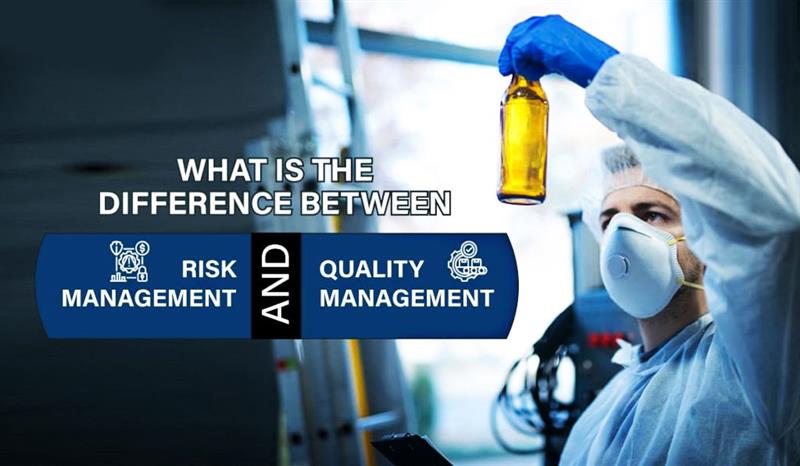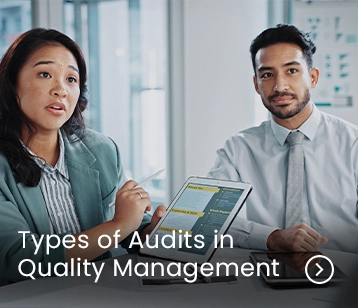
These days, quality has become paramount for all the business organizations. Regardless of the industry they operate in, or the scale of their operations, quality is at the forefront of everything they do. In fact, more and more businesses are taking steps for continuous quality improvement in their products and services, so as to meet the customer requirements as well as the stringent compliance standards.
This focus on continual improvement helps the organizations drive operational excellence, which also has two fundamental aspects as pre-requisites: Quality Management and Risk Management. Both these aspects go a long way in helping businesses achieve their quality objectives, and in fact are often considered as the two sides of the same coin.
But can they actually be referred to as the two sides of a coin, or are they different? And if yes, then how does risk management differ from quality management? What is it about risk management vs quality management system? Let’s try and answer the questions for you all through this blog. But before starting, let’s take a look at the concept of risk management and quality management through their definitions.
Quality Management
Quality Management can be thought of as a tool or a mechanism that allows organizations to design and deliver products or services while taking care of the quality and compliance requirements. It ensures that the products and/or services delivered are of consistent quality, every single time, and the quality processes are:
- Effective, as in they help create products/services that meet or exceed the customer’s expectations
- Efficient in a way that they allow creation of products and services without wasting any resources
- Economical in the sense that they allow generation of requisite revenues so that the organization can be sustained
Quality Management basically has four key components namely: Quality Control, Quality Assurance, Quality Improvement, and Quality Planning. Its objective is not just to focus on the quality of products/services, but also on the means to achieve it. Quality is all about the product, process, or system performing as per its planned or desired function.
Quality Management involves the development, implementation, and application of standard operating procedures (SOPs), tests, policies, and corrective processes, etc. to ensure that the organizations deliver intended results on the quality front from the end customer’s perspective.
Risk Management
As far as risk management is concerned, it is a tool to identify, evaluate, prioritize, and address potential risks in order to monitor, control, and even eliminate the possibilities of unfortunate events happening, and thus help the organization achieve its objectives. It’s an approach that can be termed as proactive, predictive, preventive, and preemptive.
Application of risk management allows organizations to make informed decisions based on the identified risks, and consequently keep the quality of the products intact by maintaining a strong relationship with different stakeholders including customers, suppliers, and the employees. The process, which may be lengthy and tedious, is worthy enough as it helps prevent costly reworks, recalls, and non-conformances.
It is an extremely important function for organizations because in the absence of risk management, an organization cannot possibly define its future business objectives in an effective manner. Any business objective that’s being defined without taking the risks into account is bound to miss its mark, with the organization losing its direction once the risks hit the business.
Quality Management & Risk Management in modern context
Not till too long ago, organizations used to operate smoothly on the back of some sound forecasting. However, the uncertain economic times brought about by the COVID-19 pandemic forced the organizations to change their ways. Now the same organizations refrain from making business predictions, and instead have shifted focus towards managing risk.
Organizations nowadays realize risk is the prime cause of uncertainty for them, and hence focus their energies on identifying risks and managing them proactively before they become a potential problem and affect business. Though they can’t control the external risks such as political issues, interest rates, and so on, they definitely can manage the internal risks like non-compliance, among several others.
The whole idea behind risk management is to ensure that the organizations keep the risks under control so that they can achieve their primary objectives of continuous improvement and designing & delivering quality products and services. Needless to say, at the core remains the objective of delivering quality to the end consumer.
Two distinct functional areas with same end objective
Even as Quality Management and Risk Management work as two distinct functional areas, they are actually intricately linked with each other. While quality is an end objective organizations keep in mind during production of goods or delivery of service, risk is essentially the effect of uncertainty on that objective.
Risk management is about managing these effects of uncertainty on the end objective of quality, and a tool that can be used for managing these effects could be quality management. It is thus safe to say that at some level, risk management is inherent in a quality management approach.
We have discussed about Quality Management in detail in our previous blog (Also here). Talking about Risk Management in particular, it ensures that organizations meet compliance standards while having an effective decision-making structure in place. It also ensures organizations experience improvements in terms of efficiency as well as consistency of the quality, also the objectives of quality management.
Few other benefits of risk management include:
- Helps establish a proactive culture that fosters improvement
- Assures quality consistency
- Facilitates improved customer satisfaction and loyalty
- Provides opportunity to improve operational efficiency
- Helps build greater confidence amongst stakeholders
- Facilitates improved system performance
How the two are aligned
In the current scenario, businesses need a clear understanding of the risks involved in the product or process outputs while implementing a quality management system. They need an idea about potential severity and possibility of any unforeseen event happening. This information allows them to train their focus of efforts on the areas of greatest risk within the quality management system.
Facilitates improved customer satisfaction and loyalty Provides opportunity to improve operational efficiency Helps build greater confidence amongst stakeholders Facilitates improved system performance
Conclusion
To sum up, the quality management and risk management processes are inherently linked. From an organization’s perspective, it is important that both the processes are effectively implemented, and integrate with each other in a seamless manner.
The two might be functionally divided in most of the organizations, but the key for the organizations lies in effectively linking both the quality and risk processes with continuous, clear, and transparent two-way communication flows.
We hope this blog could help you understand the concept of risk management and quality management. If you have any query on the subject, or want to know more about our quality management software, you may write to us to schedule a demo or a no-obligation discussion with our quality experts at QualityPro.





